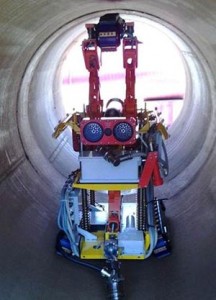From Alyeska:

This is a tale of perfect timing and imperfect piping, insistent independence and trusted teamwork, hundreds of hurdles and millions in savings, a simple Russian robot and a seismic company culture shift.
This is the story of the Robotic Inline Inspection Tool Team, which received Alyeska’s 2015 Atigun Award for Innovation. The seven team winners, and the dozens of individuals, teams and organizations that supported the effort, were all integral in a game-changing three-year journey that led to the world’s first crawler pig integrity inspection of a liquid pipeline: the Trans-Alaska Pipeline System, known as TAPS.
In the summer of 2014, a 200-pound Russian-owned robotic crawler pig inspected around 850 feet of 36 inch buried TAPS piping at Pump Station 3, providing a level of clarity on its system integrity that was previously inaccessible. The success of that inspection resulted in reduced risk and significant cost savings for Alyeska and TAPS. It also inspired similar inspections – as well as similar cost savings and risk reduction – in 2015 and the years ahead.
“There were so many people and teams involved; we all did our jobs, and we did our jobs well,” said Bhaskar Neogi, Alyeska Senior Director of Risk and Compliance. “But this was also about luck, perseverance, stubbornness not to give up, and a willingness not to worry about if we failed.”
Almost immediately after the 2011 Pump Station 1 spill incident, Alyeska leaders had discussions about risk ranking of all TAPS pipe, the pipe’s expensive replacement options, and new approaches and technology of pipe inspection. Neogi met with a vendor, Russia-based Diakont, at an Outside conference. A few months later, he tested the tool and liked what he saw. Although “simple” in his words, Neogi noted the robotic crawler’s numerous sensors, its three points of contact that allowed for smooth travel around curves and bends, and the instant data it provided. The only problem: the machines had only inspected gas lines, never liquid pipelines.
Still, Neogi shared news of the tool with key TAPS staff and leadership. Almost everyone bought in, though many also were concerned about testing, and possibly using, new system integrity technology inside TAPS. There were many regulatory hurdles ahead from local, state and national agencies, as well as countless meetings and even public hearings. There was the process of identifying a testing area. And then there was TAPS history.
“TAPS is not a guinea pig,” Neogi said. “TAPS is 100 percent assurance. You didn’t try new things on TAPS. And there was no precedence for this. But the culture of our company had changed under President Tom Barrett. Tom backed this project. He said, ‘What’s the opportunity cost? If there’s potential for a big benefit, be brave and try it.’”
The best news: “It went really well – the pipe didn’t need a single repair, there wasn’t much corrosion,” Neogi said.
This year, the inspection tool was used on pipe at Pump Stations 3, 4, 9 and 10. In 2016, it will travel to Pump Station 1 and Valdez.
• Submitted by Alyeska Corporate Communications.